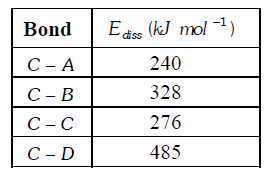The table shown below gives the bond dissociation energies (Ediss) for single covalent bonds of carbon (C ) atoms with element A, B , Z and D. which element has the smallest atoms ?
BondEdiss(kJmol−1)C−A240C−B328C−Z276C−D485
A
B
C
D
The correct Answer is:D
Step by step video & image solution for The table shown below gives the bond dissociation energies (E_("diss")) for single covalent bonds of carbon (C ) atoms with element A, B , Z and D. which element has the smallest atoms ? {:(Bond,,E_("diss")("kJ"mol^(-1))),(C-A,,240),(C-B,,328),(C-Z,,276),(C-D,,485):} by Chemistry experts to help you in doubts & scoring excellent marks in Class 12 exams.
Updated on:21/07/2023Topper's Solved these Questions
- CHEMICAL BONDING & MOLECULAR STRUCTURE BOOK - VMC MODULES ENGLISHCHAPTER - CHEMICAL BONDING & MOLECULAR STRUCTURE EXERCISE - IN-CHAPTER EXERCISE-D
10 Videos
- CHEMICAL BONDING & MOLECULAR STRUCTURE BOOK - VMC MODULES ENGLISHCHAPTER - CHEMICAL BONDING & MOLECULAR STRUCTURE EXERCISE - IN-CHAPTER EXERCISE-E
8 Videos
- CHEMICAL BONDING & MOLECULAR STRUCTURE BOOK - VMC MODULES ENGLISHCHAPTER - CHEMICAL BONDING & MOLECULAR STRUCTURE EXERCISE - IN-CHAPTER EXERCISE-B
10 Videos
- CHEMICAL BONDING & CHEMICAL STRUCTURE BOOK - VMC MODULES ENGLISHCHAPTER - CHEMICAL BONDING & CHEMICAL STRUCTURE EXERCISE - IMPECCABLE
50 Videos
- CHEMICAL BONDING-I & IIBOOK - VMC MODULES ENGLISHCHAPTER - CHEMICAL BONDING-I & IIEXERCISE - JEE Advanced (Archive)
98 Videos
Similar Questions
The table shown below gives the bond dissociation energies (Ediss) for single covalent bonds of carbon (C ) atom with element A,B,c and D. Which element out of these has the smallest atoms ?

View SolutionThe table given below lists the bound dissociation energy (Ediss) for single covalent bonds formed between C and atom A,B,D,E.
What of the atoms has smallest size?
View SolutionThe table given below lists the bond dissociation energy (Ediss) for single covalent bonds formed between C and atoms A, B, D, E.
BondEdiss(kcal mol−1)C−A 240C−B 382C−D 276C−E 486
Which of the atoms has smallest size ?
View SolutionIdentify A, B, C, D, E and F in the table given below :

View SolutionIdentify A, B, C, D, E and F in the table given below :

View SolutionThe bond energy (in kcal mol−1) of a C−c single bond is approximately
View SolutionThe bond energy (in kcal mol−1) of a C−C single bond is approximately
View SolutionIn the table given below, six elements are shown with their atomic numbers given in parenthesis.

Among elements A, B, C, which one has largest atomic size.
View Solution
Arrange the (C-H) bonds x, y and z in decreasing order of their bond dissociation energies in homolysis.
View SolutionA radioactive element A on disintegration gives two elements B and C. If B is helium and C is the element of atomic number 90 and atomic mass 234, the element A is:
View Solution
